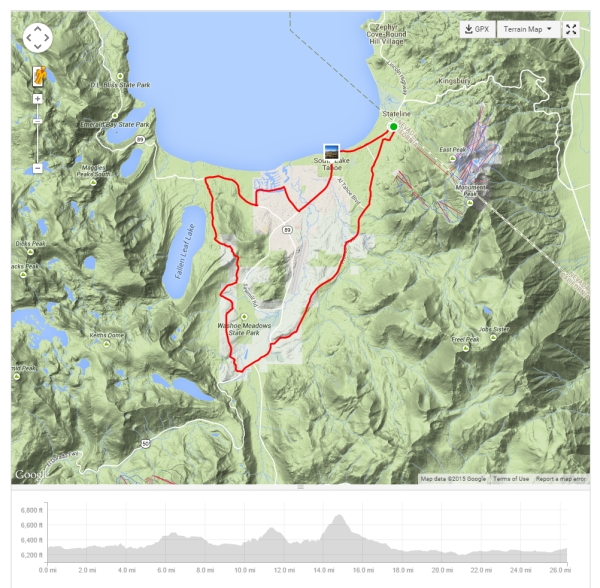Stage 5 of my own, personal “Tour of Lake Tahoe” was another relatively short one. The forecast earlier in the week had called for rain today, and I figured today would be a welcome rest day after yesterday’s epic “Stage 4” (72 miles around Lake Tahoe in under 4 hours). I awoke today, however, to blue skies and temps already near 50 and knew I would have to ride. Nevertheless, tomorrow’s “Stage 6″—the Queen stage of the week—still loomed, so I didn’t want to do anything long or too hard. Despite the amount of riding I’ve done around Lake Tahoe over the years, there still remained a number of roads around the outskirts of South Lake Tahoe that I haven’t ridden yet (or even been on by car). After some quality time with my family touring our favorite spots around Lake Tahoe, I looked at the map and put together a 26-mile route that headed west of town and then veered north towards the lake on several still unexplored roads in the south Lake Tahoe Basin, including North Upper Truckee Road, Lake Tahoe Blvd., Tahoe Mountain Road, and Fallen Leaf Road.

A burned out area of forest along Tahoe Mountain Road.
The scenery was spectacular, to say the least. Upper Truckee Road took me through serene forest along gentle grades. That all changed after turning on to Lake Tahoe Blvd., which lead into a huge area that destroyed some years back by wildfire. New home construction in the area was booming—I wondered if these were rebuilds of previous residents who lost everything or new construction by newcomers who presumed there was no longer a wildfire risk to worry about (I suspect the former). The burned out area stretched all along the south side of Angora Ridge, and before I began the (relatively easy) climb up Tahoe Mountain Road I paused and was reminded that Mother Nature is boss here.

Fallen Leaf Road
Crossing over the ridge to the north side, I stumbled onto an awesome descent down Tahoe Mountain Road that is normally closed during the winter months. However, with the lack of snow this winter and temperatures already spring-like the gate was open and I decided to go for it. I wasn’t completely confident that I wouldn’t eventually run into a dead end, but I figured the worst that could happen was that I would have to turn around and go back—okay. It was an incredible descent—narrow and winding on a surprisingly good asphalt surface, and just steep enough to build speed but not so much that I had to constantly scrub on the brakes. It was an almost perfect descent—all the smoothness and speed of the road combined with the wild solitude of mountain biking.

Only the shadow knows.
The descent down Tahoe Mountain Road lead to Fallen Leaf Road, and from there it was a 2-mile stretch along equally stunning forest alongside Fallen Leaf Lake, though unlike Tahoe Mountain Road the pavement was very choppy—so much so that I welcomed being dumped back out onto Hwy 89. By that time, the setting sun signaled an end to the day’s ride as I headed back towards the lodge.
Stage 5 covered 26.3 miles in 1:40:22 (avg speed a very leisurely 15.8 mph) with a modest 1,204 ft of climbing. This brings the combined totals for Stages 1–5 to 220.3 miles in 12:42:05 (avg 17.3 mph) with 16,437 ft of ascent. Tomorrow’s ride is Stage 6, the “Queen” stage, and was without doubt one of the hardest rides I have ever attempted—more than 100 miles and more than 10,000 ft of climbing! I survived, obviously, so stay tuned for that story.
© Ted C. MacRae 2015




